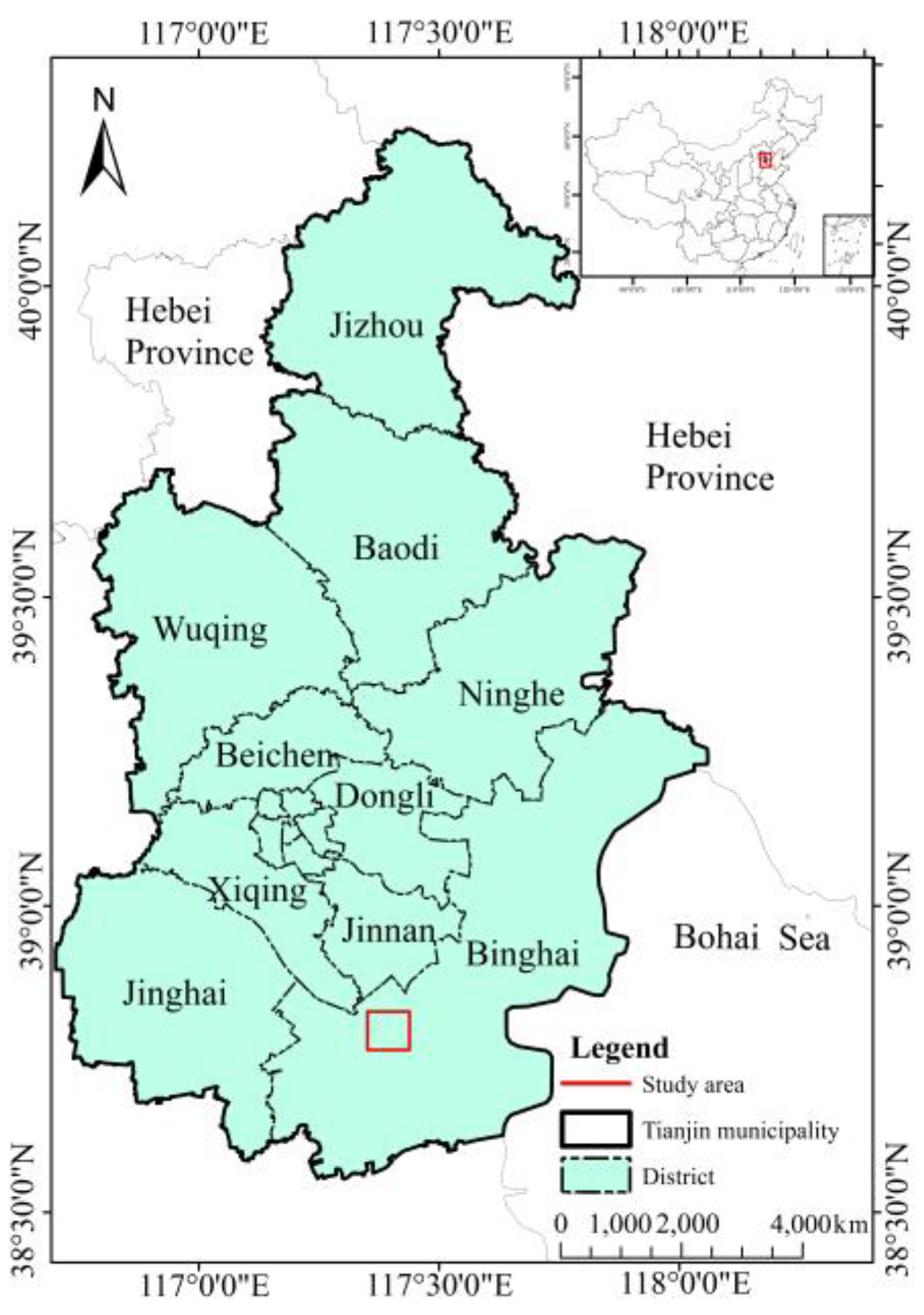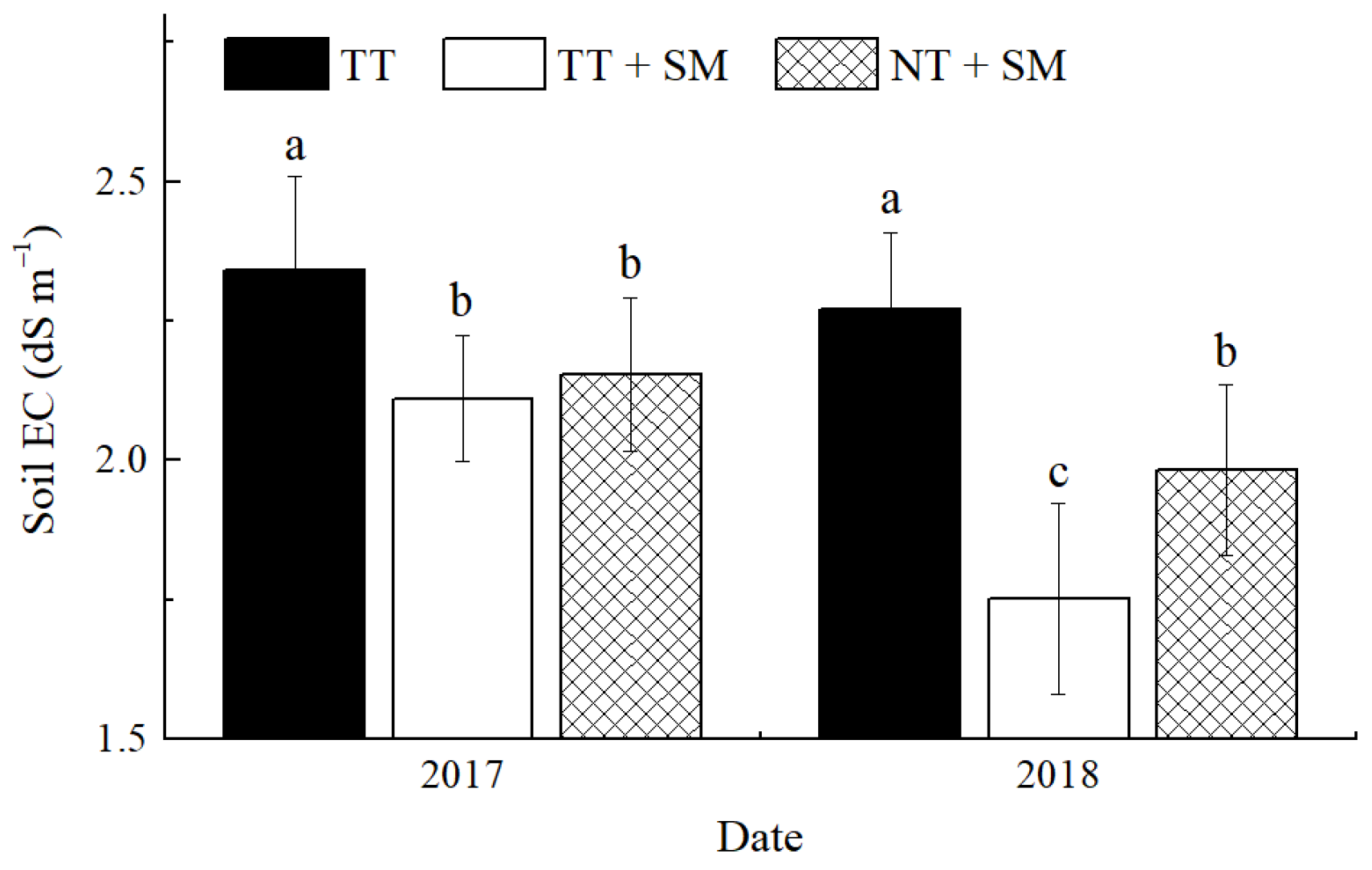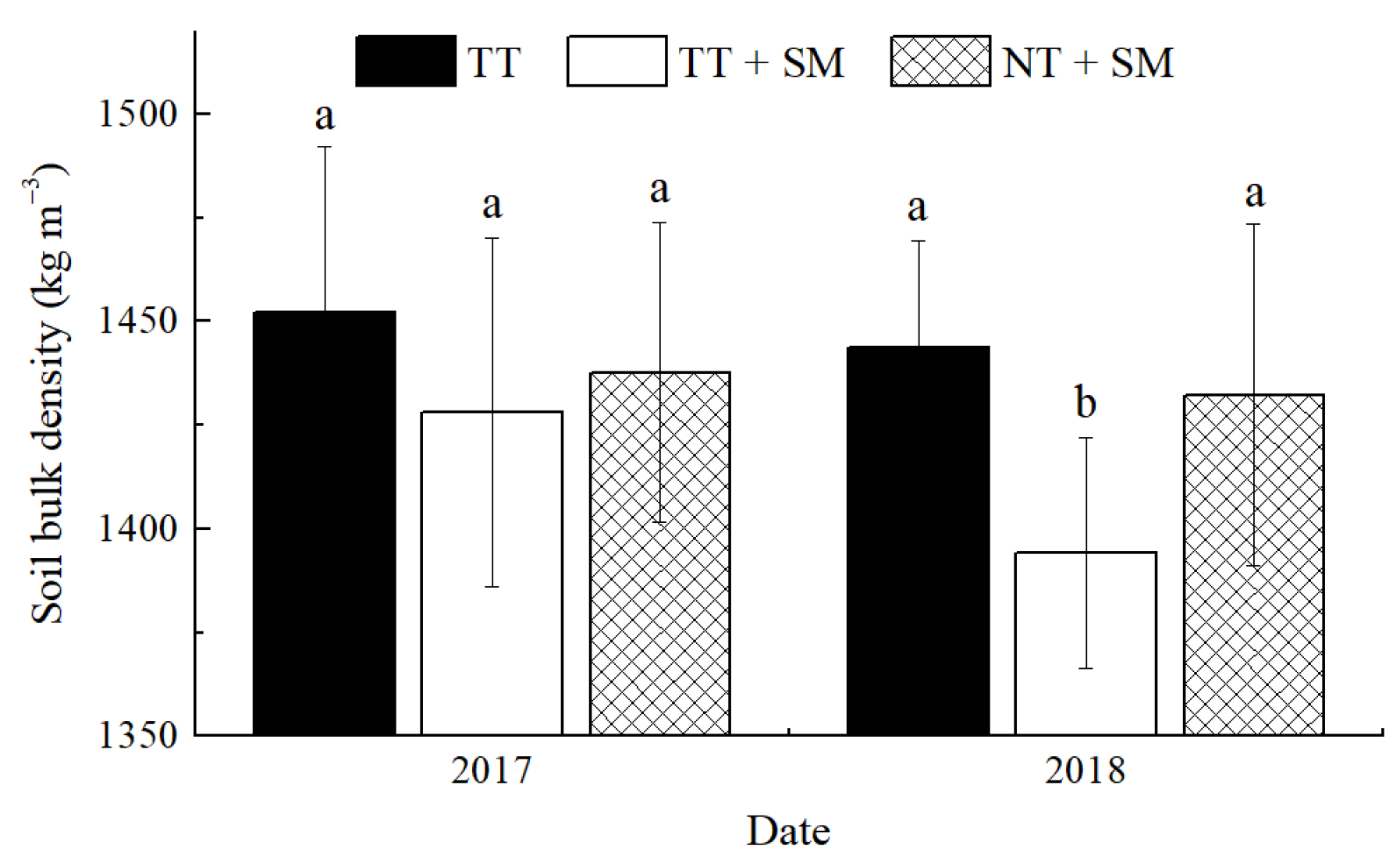Residue Mulching Alleviates Coastal Salt Accumulation and Stimulates Post-Fallow Crop Biomass under a Fallow–Maize (Zea mays L.) Rotation System
Abstract
:1. Introduction
2. Materials and Methods
2.1. Experimental Site and Soil
2.2. Experimental Design
2.3. Sampling and Measurement
2.4. Statistical Analyses
3. Results
3.1. Soil EC
3.2. Total Salt
3.3. SOM
3.4. Soil Bulk Density
3.5. SWC
3.6. Crop Performance
4. Discussion
5. Conclusions
Author Contributions
Funding
Institutional Review Board Statement
Informed Consent Statement
Data Availability Statement
Conflicts of Interest
References
- Kumawat, K.C.; Nagpal, S.; Sharma, P. Potential of plant growth-promoting rhizobacteria-plant interactions in mitigating salt stress for sustainable agriculture: A review. Pedosphere 2022, 32, 223–245. [Google Scholar] [CrossRef]
- Marsack, J.M.; Connolly, B.M. Generalist herbivore response to volatile chemical induction varies along a gradient in soil salinization. Sci. Rep. 2022, 12, 1689. [Google Scholar] [CrossRef] [PubMed]
- Li, Y.Q.; Chai, Y.H.; Wang, X.S.; Huang, L.Y.; Luo, X.M.; Qiu, C.; Liu, Q.H.; Guan, X.Y. Bacterial community in saline farmland soil on the Tibetan plateau: Responding to salinization while resisting extreme environments. BMC Microbiol 2021, 21, 119. [Google Scholar] [CrossRef] [PubMed]
- Cho, K.H.; Beon, M.; Jeong, J. Dynamics of soil salinity and vegetation in a reclaimed area in Saemangeum, Republic of Korea. Geoderma 2018, 321, 42–51. [Google Scholar] [CrossRef]
- Lv, Z.Z.; Liu, G.M.; Yang, J.S.; Zhang, M.M.; He, L.D.; Shao, H.B.; Yu, S.P. Spatial variability of soil salinity in Bohai Sea coastal wetlands, China: Partition into four management zones. Plant Biosyst. Int. J. Deal. All Asp. Plant Biol. 2013, 147, 1201–1210. [Google Scholar] [CrossRef] [Green Version]
- Liu, S.; Hou, X.; Yang, M.; Cheng, F.; Coxixo, A.; Wu, X.; Zhang, Y. Factors driving the relationships between vegetation and soil properties in the Yellow River Delta, China. Catena 2018, 165, 279–285. [Google Scholar] [CrossRef]
- Yu, P.; Liu, S.; Yang, H.; Fan, G.; Zhou, D. Short-term land use conversions influence the profile distribution of soil salinity and sodicity in northeastern China. Ecol. Indic. 2018, 88, 79–87. [Google Scholar] [CrossRef]
- Wang, X.; Li, Z.; Xing, Y. Effects of mulching and nitrogen on soil temperature, water content, nitrate-N content and maize yield in the Loess Plateau of China. Agric. Water Manag. 2015, 161, 53–64. [Google Scholar] [CrossRef]
- She, D.; Liu, D.; Liu, Y.; Liu, Y.; Xu, C.; Qu, X.; Chen, F. Profile characteristics of temporal stability of soil water storage in two land uses. Arab. J. Geosci. 2014, 7, 21–34. [Google Scholar] [CrossRef]
- Gao, L.; Shao, M.; Peng, X.; She, D. Spatio-temporal variability and temporal stability of water contents distributed within soil profiles at a hillslope scale. Catena 2015, 132, 29–36. [Google Scholar] [CrossRef]
- Xie, X.; Pu, L.; Wang, Q.; Zhu, M.; Xu, Y.; Zhang, M. Response of soil physicochemical properties and enzyme activities to long-term reclamation of coastal saline soil, Eastern China. Sci. Total Environ. 2017, 607, 1419–1427. [Google Scholar] [CrossRef] [PubMed]
- Shi, S.; Tian, L.; Nasir, F.; Bahadur, A.; Batool, A.; Luo, S.; Yang, F.; Wang, Z.; Tian, C. Response of microbial communities and enzyme activities to amendments in saline-alkaline soils. Appl. Soil. Ecol. 2019, 135, 16–24. [Google Scholar] [CrossRef]
- Williams, A.; Kay, P.; Stirling, G.; Weng, X.; Bell, L. Impacts of reducing fallow periods on indicators of soil function in subtropical dryland farming systems. Agric. Ecosyst. Environ. 2022, 324, 107727. [Google Scholar] [CrossRef]
- Ti, J.; Yang, Y.; Pu, L.; Wen, X.; Yin, X.; Chen, F. Ecological compensation for winter wheat fallow and impact assessment of winter fallow on water sustainability and food security on the North China Plain. J Clean Prod 2021, 328, 129431. [Google Scholar] [CrossRef]
- Li, G.; Zhang, M.; Wu, C. Short-term fallow practices drive soil bacterial community changes: A case study from China. Appl. Soil. Ecol. 2021, 165, 103988. [Google Scholar] [CrossRef]
- Passioura, J.B.; Angus, J.F. Improving Productivity of Crops in Water-Limited Environments. Adv. Agron. 2010, 106, 37–75. [Google Scholar] [CrossRef]
- Tanwar, S.P.S.; Rao, S.S.; Regar, P.L.; Datt, S.; Praveen-Kumar; Jodha, B.S.; Santra, P.; Kumar, R.; Ram, R. Improving water and land use efficiency of fallow-wheat system in shallow Lithic Calciorthid soils of arid region: Introduction of bed planting and rainy season sorghum-legume intercropping. Soil Tillage Res. 2014, 138, 44–55. [Google Scholar] [CrossRef]
- Guan, S.; Liu, S.; Liu, R.; Zhang, J.; Ren, J.; Cai, H.; Lin, X. Soil organic carbon associated with aggregate-size and density fractions in a Mollisol amended with charred and uncharred maize straw. J. Integr. Agric. 2019, 18, 1496–1507. [Google Scholar] [CrossRef]
- Zhang, P.; Chen, X.; Wei, T.; Yang, Z.; Jia, Z.; Yang, B.; Han, Q.; Ren, X. Effects of straw incorporation on the soil nutrient contents, enzyme activities, and crop yield in a semiarid region of China. Soil Tillage Res. 2016, 160, 65–72. [Google Scholar] [CrossRef]
- Stagnari, F.; Galieni, A.; Speca, S.; Cafiero, G.; Pisante, M. Effects of straw mulch on growth and yield of durum wheat during transition to Conservation Agriculture in Mediterranean environment. Field Crops Res. 2014, 167, 51–63. [Google Scholar] [CrossRef]
- Akhtar, K.; Wang, W.; Ren, G.; Khan, A.; Feng, Y.; Yang, G. Changes in soil enzymes, soil properties, and maize crop productivity under wheat straw mulching in Guanzhong, China. Soil Tillage Res. 2018, 182, 94–102. [Google Scholar] [CrossRef]
- Wang, M.; Chen, W.; Song, X.; Li, X.; Hu, Q.; Deng, C. Preliminary Study on Effect of Straw Mulching and Incorporation on Water and Salt Movement in Salinized Soil. Acta Pedol. Sin. 2017, 54, 1395–1403. (In Chinese) [Google Scholar]
- Mao, L.; Guo, W.; Yuan, Y.; Qin, D.; Wang, S.; Nie, J.; Zhao, N.; Song, X.; Sun, X. Cotton stubble effects on yield and nutrient assimilation in coastal saline soil. Field Crops Res. 2019, 239, 71–81. [Google Scholar] [CrossRef]
- Yang, Y. Effects of Fallow Rotation on Soil Aggregates and Its Nutrients in Maize Land under Straw Returning to Field; University of Chinese Academy of Sciences: Beijing, China, 2019. (In Chinese) [Google Scholar]
- Liu, E.; Yan, C.; Mei, X.; He, W.; Bing, S.H.; Ding, L.; Liu, Q.; Liu, S.; Fan, T. Long-term effect of chemical fertilizer, straw, and manure on soil chemical and biological properties in northwest China. Geoderma 2010, 158, 173–180. [Google Scholar] [CrossRef]
- Zhang, Y.; Zhang, R.; Zhang, B.; Xi, X. Artificial Macropores with Sandy Fillings Enhance Desalinization and Increase Plant Biomass in Two Contrasting Salt-Affected Soils. Appl. Sci. 2021, 11, 3037. [Google Scholar] [CrossRef]
- He, J.; Li, H.; McHugh, A.D.; Wang, Q.; Lu, Z.; Li, W.; Zhang, Y. Permanent raised beds improved crop performance and water use on the North China Plain. J. Soil. Water Conserv. 2015, 70, 54–62. [Google Scholar] [CrossRef]
- Zhang, Y.; Wang, W.; Yuan, W.; Zhang, R.; Xi, X. Cattle Manure Application and Combined Straw Mulching Enhance Maize (Zea mays L.) Growth and Water Use for Rain-Fed Cropping System of Coastal Saline Soils. Agriculture 2021, 11, 745. [Google Scholar] [CrossRef]
- Deng, L.; Wei, W.; Hu, J.; Jiang, X.; Yang, J.; Ge, Y.; Dong, J.; Zhang, Y.; Wu, Q. Effects of Straw Mulching on Water and Salt Movement in Coastal Saline-alkali Soil. J. Agric. 2017, 7, 23–26. (In Chinese) [Google Scholar]
- Yusefi, A.; Farrokhian Firouzi, A.; Aminzadeh, M. The effects of shallow saline groundwater on evaporation, soil moisture, and temperature distribution in the presence of straw mulch. Hydrol. Res. 2020, 51, 720–738. [Google Scholar] [CrossRef]
- He, G.; Wang, Z.; Li, F.; Dai, J.; Li, Q.; Xue, C.; Cao, H.; Wang, S.; Malhi, S.S. Soil water storage and winter wheat productivity affected by soil surface management and precipitation in dryland of the Loess Plateau, China. Agric. Water Manag. 2016, 171, 1–9. [Google Scholar] [CrossRef]
- Choudhary, V.; Kumar, S. Influence of mulching on productivity, root growth and weed dynamics of maize (Zea mays) based cropping systems. Indian J. Agron. 2014, 59, 364–370. [Google Scholar]
- Zhao, H.; Mao, A.; Yang, H.; Wang, T.; Dou, Y.; Wang, Z.; Malhi, S. Summer fallow straw mulching and reducing nitrogen fertilization: A promising practice to alleviate environmental risk while increasing yield and economic profits of dryland wheat production. Eur. J. Agron. 2022, 133, 126440. [Google Scholar] [CrossRef]
- Xue, J.-F.; Yuan, Y.-Q.; Zhang, H.-L.; Ren, A.-X.; Lin, W.; Sun, M.; Gao, Z.-Q.; Sun, D.-S. Carbon footprint of dryland winter wheat under film mulching during summer-fallow season and sowing method on the Loess Plateau. Ecol. Indic. 2018, 95, 12–20. [Google Scholar] [CrossRef]
- Choudhary, V.K.; Meena, R.S. Assessment of diverse tillage system with mulching for water-cum-energy efficiency and soil carbon stabilization in maize (Zea mays L.)-rapeseed (Brassica campestris L.) system. Soil Tillage Res. 2022, 219, 105326. [Google Scholar] [CrossRef]
- Zhang, Y.; Tan, C.; Wang, R.; Li, J.; Wang, X. Conservation tillage rotation enhanced soil structure and soil nutrients in long-term dryland agriculture. Eur. J. Agron. 2021, 131, 126379. [Google Scholar] [CrossRef]
- Mijangos, I.; Albizu, I.; Garbisu, C. Beneficial Effects of Organic Fertilization and No-Tillage on Fine-Textured Soil Properties Under Two Different Forage Crop Rotations. Soil Sci. 2010, 175, 173–185. [Google Scholar] [CrossRef]
- Pittelkow, C.M.; Liang, X.; Linquist, B.A.; van Groenigen, K.J.; Lee, J.; Lundy, M.E.; van Gestel, N.; Six, J.; Venterea, R.T.; van Kessel, C. Productivity limits and potentials of the principles of conservation agriculture. Nature 2015, 517, 365–482. [Google Scholar] [CrossRef] [PubMed]
- Serraj, R.; Siddique, K.H.M. Conservation agriculture in dry areas. Field Crops Res. 2012, 132, 1–6. [Google Scholar] [CrossRef]





| Items | Mean Value | Unit |
|---|---|---|
| Sand (0.05~2 mm) | 10.6 | % |
| Silt (0.002~0.05 mm) | 61.0 | % |
| Clay (<0.002 mm) | 28.4 | % |
| Soil bulk density | 1.39 | g cm−3 |
| Field capacity (by weight) | 28.4 | % |
| Total porosity | 46.5 | % |
| Rotation Design | Start or Planting Date | End or Harvest Date | Precipitation (mm) |
|---|---|---|---|
| Prior to experiment | Late September 2016 | ||
| Fallow | Late September 2016 | Early June 2017 | 105.1 |
| Maize cropping | Early June 2017 | Late September 2017 | 350.3 |
| Fallow | Late September 2017 | Early June 2018 | 162.9 |
| Maize cropping | Early June 2018 | Late September 2018 | 433.3 |
| Treatment Identifiers | Total Salt (g/m2) | SOM (g/kg) | |
|---|---|---|---|
| Year | Treatments | ||
| 2017 | TT | 3551.9 a | 16.04 a |
| TT + SM | 3149.5 b | 17.08 a | |
| NT + SM | 3236.2 b | 16.61 a | |
| 2018 | TT | 3424.0 a | 16.65 b |
| TT + SM | 2553.7 c | 19.61 a | |
| NT + SM | 2969.6 b | 17.29 b | |
| Treatment Identifiers | Plant Height (cm) | Root Dry Weight (g/plant) | Grain Yield (kg/hm2) | |
|---|---|---|---|---|
| Year | Treatments | |||
| 2017 | TT | 164.8 a | 43.9 b | 4655.3 b |
| TT + SM | 173.7 a | 52.1 a | 5009.7 a | |
| NT + SM | 170.3 a | 46.2 b | 4741.3 b | |
| 2018 | TT | 172.5 a | 47.2 b | 4789.3 b |
| TT + SM | 181.2 a | 54.8 a | 5331.0 a | |
| NT + SM | 179.3 a | 51.4 a b | 4914.7 b | |
| Variation Source | Degree of Freedom | Mean Square | F-Value | p-Value |
|---|---|---|---|---|
| T | 2 | 329,061.5556 | 45.5246 ** | 0.0001 |
| Y | 1 | 197,610.3889 | 27.3388 ** | 0.0008 |
| Y × T | 2 | 14,636.2222 | 2.0249 | 0.1943 |
| Error | 8 | 7228.2222 | ||
| Total variation | 17 |
Publisher’s Note: MDPI stays neutral with regard to jurisdictional claims in published maps and institutional affiliations. |
© 2022 by the authors. Licensee MDPI, Basel, Switzerland. This article is an open access article distributed under the terms and conditions of the Creative Commons Attribution (CC BY) license (https://creativecommons.org/licenses/by/4.0/).
Share and Cite
Zhang, Y.; Yuan, W.; Han, L. Residue Mulching Alleviates Coastal Salt Accumulation and Stimulates Post-Fallow Crop Biomass under a Fallow–Maize (Zea mays L.) Rotation System. Agriculture 2022, 12, 509. https://doi.org/10.3390/agriculture12040509
Zhang Y, Yuan W, Han L. Residue Mulching Alleviates Coastal Salt Accumulation and Stimulates Post-Fallow Crop Biomass under a Fallow–Maize (Zea mays L.) Rotation System. Agriculture. 2022; 12(4):509. https://doi.org/10.3390/agriculture12040509
Chicago/Turabian StyleZhang, Yifu, Wei Yuan, and Lianjie Han. 2022. "Residue Mulching Alleviates Coastal Salt Accumulation and Stimulates Post-Fallow Crop Biomass under a Fallow–Maize (Zea mays L.) Rotation System" Agriculture 12, no. 4: 509. https://doi.org/10.3390/agriculture12040509







